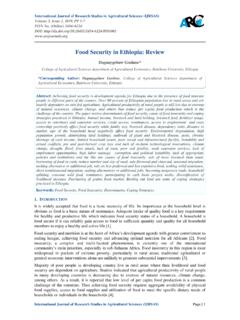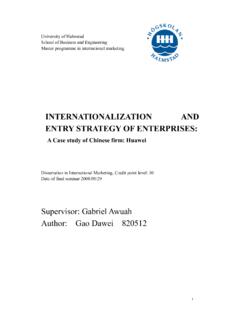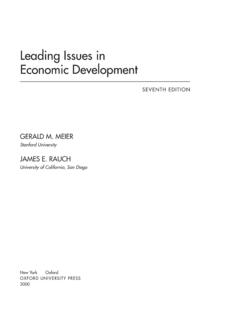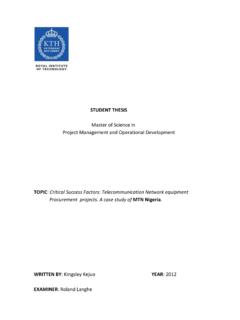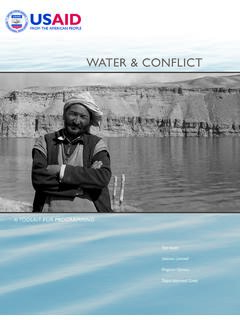Transcription of IMPACT / CONTRIBUTIONS OF MISSIONARIES IN AFRICA. …
1 IMPACT / CONTRIBUTIONS OF MISSIONARIES IN africa . The CONTRIBUTIONS were both positive and negative and they included the following: Positive CONTRIBUTIONS : They preached and spread Christianity among Africans like in Matebele/. Mashona land in Central africa , Buganda in East africa , Yorubaland, Sierra Leone in West africa etc. This was done through their teachings and preaching and in the process many people accepted and converted to Christianity more so in the area where they operated. Established Churches for the spread of Christianity and training of catechists forexample, Namirembe Cathedral, Rubaga Cathedral, All saints churches in Kenya, Malawi, Yoruba land as well as the Blantyre Cathedral in Malawi plus numerous churches in Betholdrop South africa The improved the health sector through discovery of medicine like Quinine and establishment of healthy centres.
2 In Central africa by the Livingstonia Mission at Malawi,Lovedale Mission, In East africa Mulago, Mengo , Nairobi hospital, Nsambya among others. They improved the education sector through establishment of Schools. In Central africa , Over town School, Muwera, Mweda by Livingstonia mission near Manchwe falls, In West africa , Fourah Bay College, St. Gregory, Ann Waalsh institute , in East africa Alliance in Kenya, Mengo, Gayaza, Kisubi, Buddo in Uganda. They introduced informal education that taught reading, writing, arithmetic.
3 The education system also produced African Elites that aided imperialism like Semei Kakungulu who acted as secretaries, interpreters among others. They also established mission stations. In Central africa , in Lozi kingdom, South of Lake Nyasa by UMCA, at Bruman by Rev. Moffat and at Koloberyo, in East africa at Bagamoyo, Rabai mpya and Ujiji. These later enabled them to carry out their missionary work. Some of the mission stations developed into towns and administrative centres They introduced and encouraged the growing of new crops and use of new methods of farming like cocoa, palm oil, ground nuts, Tobacco, Sisal, cotton, rubber.
4 This encouraged plantation agriculture hence a cash crop economy They established modern transport and communication network like roads, railways, ports and harbors, telegraph lines. Having faced a big transport problem, they appealed to their home governments to establish such lines for example in 1890-94, there was the construction of Tanga Railway in Tanganyika and 1896 the Uganda Railway also begun. They checked on the spread of Islam in africa especially West and East africa . This was done through preaching against the Islamic doctrines of polygamy as they emphased monogamy.
5 Promoted African languages like Yoruba, Ibo, Kru, Temne, Mende, Creoles, Ngoni, Yao among others. This was done alongside teaching people new language. Some of these languages became the official languages like English in the areas where the church Missionary society operated. Besides Bishop Ajayi crowther translated the Bible into Yoruba language in Nigeria and likewise Ludwig K and Johan Rebman also translated the bible into Kiswahili in East africa . Fought against slave trade and and other inhuman practices such as the murder of twins in Ibo land, human sacrifice in Calabar, witchcraft, cannibalism among others.
6 They therefore introduced legitmate trade and more so the African diginity was restored for example in Central africa among the Amangocha Yao, East africa along the coast al areas and West africa among Senega, Nigeria Dahomey among others. They provided employment to Africans as teachers, Nurses, interpreters, Secretaries which increased standard of living. They promoted urbanization in West africa like Free Town, Abeokuta, Lagos, and Accra. This came with western culture where they promoted their style of dressing, eating habits, ways of worshp at the expense of African cultures such as celebrating the full moon and other practices like human sacrifice, polygamy among others.
7 Led to emergency of independent Churches due to the various restrictions on the African traditional religion among other causes. Established freed slave centers like Free Town in Sierra Leone and Liberia. Others were at Bagamoyo by the Holy Ghost fathers while others were in Central africa among the Amangocha Yao. The MISSIONARIES also introduced the printing press in africa and this was based in Nigeria. It was established by Reverend Henry Townsend and by 1857, there were news paper publications in Yoruba language.
8 The main news paper was known as Iwe-Illorine. The MISSIONARIES established a new type of architecture which included brick lying, building with precious stones, the use of corrugated iron sheets and also the use of decoration especially in schools, churches. This was common in all their areas of operation. The MISSIONARIES also extended their development in the economic sphere of influence. In this case, they funded trading companies when they run bankrupt. This therefore enabled the trading companies to operate in the different areas.
9 Eg, CMS funded IBEACO in 1890 when it had run Bankrupt. It also funded the R oyal Niger Company in West africa . They supplied European manufactured goods Negative CONTRIBUTIONS Led to colonization of africa . They prepared the ground such that when the colonialists came they met less resistance hence the flag followed the cross. Involved in African politics and antagonized African political fabric. De-campaigned African traditional religion Led to religious wars The education provided aided colonial administration hence loss of African Independence.
10 Neglected African technology like use of herbs/ vocational THE FACTORS THAT FACILITATED MISSIONARIES TO CARRY OUT THEIR. ACTIVITIES. (REASONS FOR THE SUCCESS OF MISSONARY ACTIVITIES). 1. Vast financial resources that is to say they had the money to finance their activities which they secured from their home government. 2. The approach they used to spread Christianity was human and enticing hence enabled them to get converts more easily. 3. Their ability to break the language barrier which eased communication between the parties and understanding.
